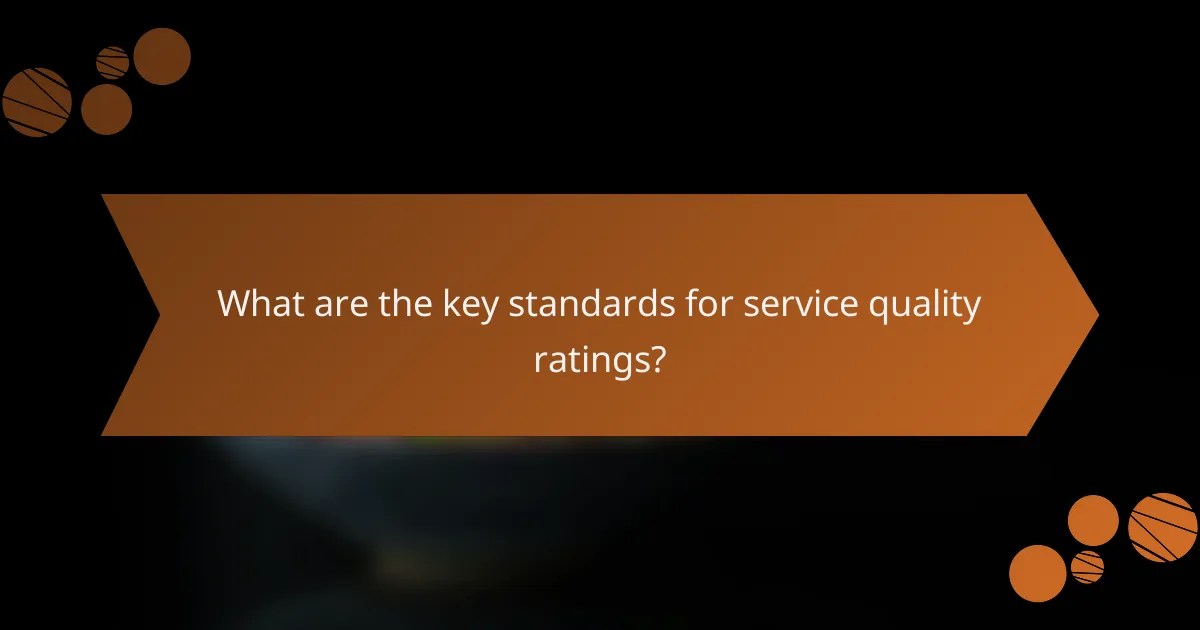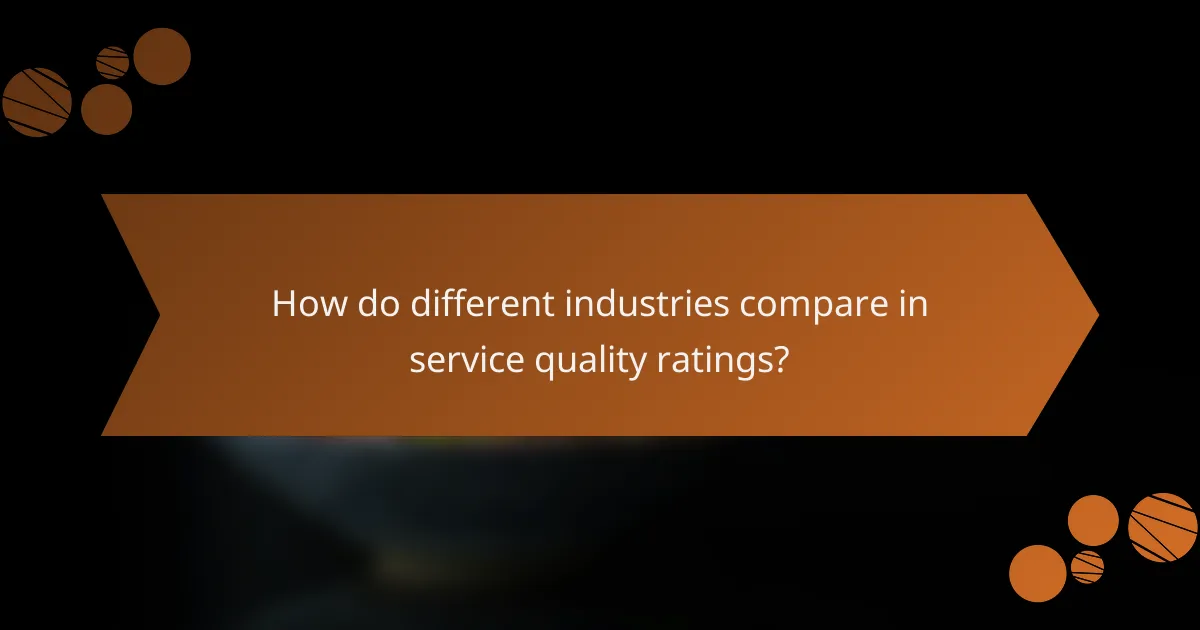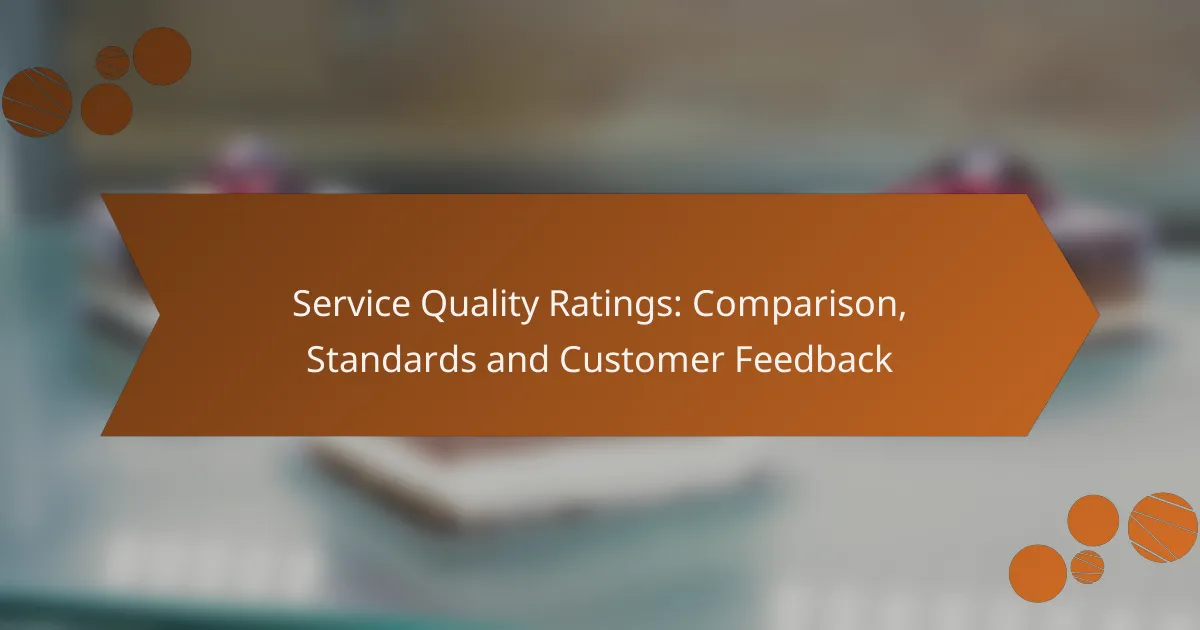Service quality ratings play a crucial role in shaping customer perceptions and influencing purchasing decisions for local businesses. By adhering to established standards and actively seeking customer feedback, organizations can enhance their service delivery, improve satisfaction, and ultimately drive revenue growth.

How do service quality ratings impact local businesses?
Service quality ratings significantly influence local businesses by shaping customer perceptions and driving purchasing decisions. High ratings can enhance reputation, attract new customers, and ultimately boost revenue.
Increased customer trust
High service quality ratings foster increased customer trust in local businesses. When potential customers see positive reviews and high ratings, they are more likely to believe that the business will meet their expectations. This trust can lead to higher foot traffic and online engagement.
To build this trust, businesses should actively encourage satisfied customers to leave positive feedback on platforms like Google, Yelp, or TripAdvisor. Regularly responding to reviews, both positive and negative, can further enhance credibility.
Enhanced competitive advantage
Service quality ratings provide a competitive advantage by differentiating a business from its competitors. In markets where multiple options exist, high ratings can sway customers to choose one business over another. This is particularly crucial in densely populated areas where competition is fierce.
Businesses can leverage their ratings in marketing campaigns, showcasing testimonials and star ratings in advertisements. Additionally, maintaining high standards of service can help sustain this advantage over time.
Improved customer retention
High service quality ratings contribute to improved customer retention, as satisfied customers are more likely to return. A positive experience encourages repeat business, which is often more cost-effective than acquiring new customers. Retention rates can significantly impact profitability for local businesses.
To enhance retention, businesses should focus on consistently delivering excellent service and addressing any issues promptly. Implementing loyalty programs or personalized follow-ups can further strengthen customer relationships and encourage repeat visits.

What are the key standards for service quality ratings?
Key standards for service quality ratings include established frameworks and metrics that help organizations assess and improve their service delivery. These standards provide a structured approach to measuring customer satisfaction and operational efficiency, ensuring consistent quality across services.
ISO 9001 certification
ISO 9001 certification is an internationally recognized standard that sets criteria for a quality management system (QMS). Organizations seeking this certification must demonstrate their ability to consistently provide products and services that meet customer and regulatory requirements.
Achieving ISO 9001 certification involves several steps, including defining quality objectives, documenting processes, and conducting regular audits. Companies often find that this certification not only improves service quality but also enhances customer trust and satisfaction.
Net Promoter Score (NPS)
Net Promoter Score (NPS) is a widely used metric that gauges customer loyalty by asking how likely customers are to recommend a service to others. Responses are typically categorized into promoters, passives, and detractors, providing a clear picture of customer sentiment.
To calculate NPS, subtract the percentage of detractors from the percentage of promoters. A high NPS indicates strong customer loyalty, while a low score may signal areas needing improvement. Regularly tracking NPS can help organizations identify trends and make informed decisions to enhance service quality.
Customer Satisfaction Score (CSAT)
Customer Satisfaction Score (CSAT) measures how satisfied customers are with a specific interaction or service. It is usually assessed through surveys that ask customers to rate their satisfaction on a scale, often from 1 to 5 or 1 to 10.
CSAT scores provide immediate feedback on customer experiences, allowing organizations to quickly address issues. A CSAT score above 80% is generally considered good, while scores below 70% may indicate the need for service improvements. Regularly collecting and analyzing CSAT data can help businesses refine their offerings and boost overall satisfaction.

How can local services improve their service quality ratings?
Local services can enhance their service quality ratings by actively seeking customer feedback, investing in staff training, and implementing robust quality assurance processes. These strategies create a cycle of continuous improvement that directly impacts customer satisfaction and loyalty.
Regular customer feedback collection
Collecting regular customer feedback is essential for understanding service quality from the customer’s perspective. This can be done through surveys, comment cards, or online reviews, allowing businesses to identify strengths and weaknesses in their services.
Consider using a mix of quantitative and qualitative feedback methods. For example, a simple rating scale (1-5) combined with open-ended questions can provide both measurable data and detailed insights. Aim to gather feedback consistently, perhaps quarterly, to track improvements over time.
Staff training programs
Investing in staff training programs is crucial for improving service quality ratings. Training should focus on customer service skills, product knowledge, and problem-solving techniques to empower employees to meet customer needs effectively.
Regular workshops and role-playing scenarios can enhance staff confidence and competence. Consider implementing a mentorship program where experienced employees guide newer staff, fostering a culture of learning and support.
Implementing quality assurance processes
Quality assurance processes help maintain high service standards by establishing clear guidelines and performance metrics. This can include regular audits, customer satisfaction benchmarks, and service delivery checklists to ensure consistency.
Utilize tools like mystery shopping or customer journey mapping to assess service quality from various angles. Regularly review these processes and adjust them based on feedback and performance data to ensure they remain effective and relevant.

What are the best platforms for gathering customer feedback?
The best platforms for gathering customer feedback include Google My Business, Yelp, and Trustpilot. Each of these platforms offers unique features that cater to different business needs and customer engagement strategies.
Google My Business
Google My Business (GMB) is a free tool that allows businesses to manage their online presence across Google, including Search and Maps. Customers can leave reviews and ratings, which can significantly influence a business’s visibility and reputation.
To maximize GMB’s effectiveness, ensure your profile is complete with accurate information, engaging photos, and regular updates. Responding to reviews promptly can enhance customer trust and encourage more feedback.
Yelp
Yelp is a popular platform for user-generated reviews, particularly in the hospitality and service industries. Businesses can claim their Yelp page to interact with customers, respond to reviews, and promote special offers.
Consider using Yelp’s advertising options to increase visibility. However, be aware that Yelp’s algorithm may prioritize certain reviews, so maintaining a consistent quality of service is crucial to garner positive feedback.
Trustpilot
Trustpilot is a review platform that focuses on transparency and trust, allowing customers to share their experiences with businesses. It is widely used across various sectors, including e-commerce and services.
To effectively use Trustpilot, encourage satisfied customers to leave reviews and consider implementing Trustpilot’s widgets on your website to display ratings. Regularly monitoring and responding to reviews can help build a positive online reputation.

How do different industries compare in service quality ratings?
Service quality ratings vary significantly across industries, influenced by factors such as customer expectations, service delivery models, and industry standards. Understanding these differences can help businesses identify areas for improvement and enhance customer satisfaction.
Healthcare vs. hospitality
In healthcare, service quality is often measured by patient outcomes, wait times, and the professionalism of staff. Patients expect high levels of care and empathy, making it crucial for healthcare providers to maintain rigorous standards and continuous training.
On the other hand, the hospitality industry focuses on customer experience, cleanliness, and responsiveness. Ratings often reflect how well establishments meet guests’ needs, with emphasis on comfort and service speed. Both sectors benefit from regular feedback mechanisms to ensure standards are met.
Retail vs. service providers
Retail service quality is typically assessed through customer interactions, product availability, and checkout efficiency. Shoppers expect quick service and knowledgeable staff, which can significantly impact their overall satisfaction and loyalty.
Service providers, such as repair or maintenance companies, are evaluated based on reliability, communication, and the quality of the service delivered. Customers often prioritize timeliness and the ability to resolve issues effectively. Both sectors should focus on training staff and implementing customer feedback systems to enhance service quality.
Local contractors vs. national chains
Local contractors often excel in personalized service and community engagement, which can lead to higher customer satisfaction ratings. They may have more flexibility in addressing specific client needs and building long-term relationships.
National chains, however, benefit from standardized processes and brand recognition, which can assure customers of consistent service quality. They often have more resources for training and technology, but may lack the personal touch that local businesses provide. Balancing these strengths and weaknesses is key for both types of service providers to improve their ratings.

What are the emerging trends in service quality ratings?
Emerging trends in service quality ratings reflect a growing emphasis on customer experience, personalization, and the integration of technology. Companies are increasingly adopting real-time feedback mechanisms and leveraging data analytics to enhance service delivery and meet evolving customer expectations.
Increased Use of Technology
Technology is reshaping how service quality is measured and improved. Many businesses are utilizing AI and machine learning to analyze customer feedback more effectively, allowing for quicker adjustments to service offerings. For example, chatbots can provide immediate responses to customer inquiries, significantly enhancing satisfaction levels.
Real-Time Feedback Mechanisms
Real-time feedback tools, such as mobile surveys and social media monitoring, are becoming standard practice. These tools enable companies to capture customer sentiments instantly, allowing for immediate action on service issues. Businesses that implement these mechanisms often see a boost in customer loyalty and retention.
Focus on Personalization
Personalization is increasingly critical in service quality ratings. Customers expect tailored experiences that cater to their specific needs and preferences. Companies that successfully leverage customer data to personalize interactions often report higher satisfaction ratings and improved customer relationships.
Emphasis on Customer Experience
The overall customer experience is now a primary focus in service quality assessments. Organizations are shifting from traditional metrics to holistic evaluations that consider every touchpoint in the customer journey. This approach helps identify pain points and areas for improvement, ultimately leading to enhanced service delivery.
